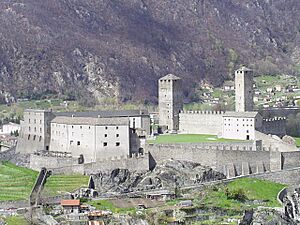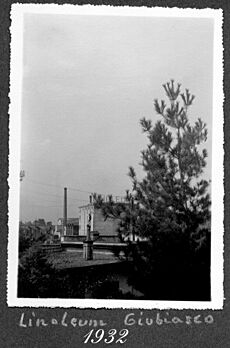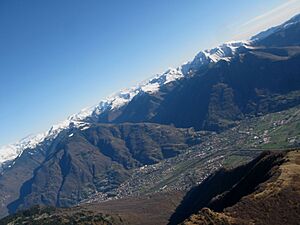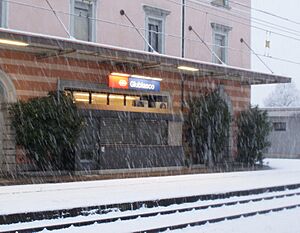Giubiasco facts for kids
Quick facts for kids
Giubiasco
|
||
|---|---|---|
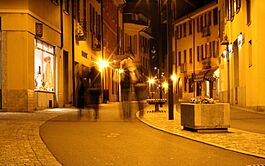 |
||
|
||
| Country | Switzerland | |
| Canton | Ticino | |
| District | Bellinzona | |
| Area | ||
| • Total | 6.2 km2 (2.4 sq mi) | |
| Elevation | 242 m (794 ft) | |
| Population
(December 2007)
|
||
| • Total | 8,162 | |
| • Density | 1,316/km2 (3,410/sq mi) | |
| Postal code |
6512
|
|
| Surrounded by | Bellinzona, Camorino, Gudo, Monte Carasso, Pianezzo, Sant'Antonino, Sementina | |
| Twin towns | Prilly (Switzerland) | |
Giubiasco was once a separate town, or municipality, in the canton of Ticino in Switzerland. It was part of the Bellinzona area.
On April 2, 2017, Giubiasco and several other towns like Camorino, Claro, and Gudo joined together. They all became part of the larger city of Bellinzona.
Contents
Giubiasco's Long History
Giubiasco has always been an important place. This is because of its special location. Many old roads through the Alps met here. Roads from Monte Ceneri in the south, Passo di San Jorio in the east, and the famous San Bernardino Pass and Gotthard Pass from the north all connected at Giubiasco. Even a route along Lake Maggiore from the west came here.
Ancient Burials: The Necropolis
In 1900, a huge ancient cemetery was found in Giubiasco. This cemetery is called a necropolis, which means "city of the dead." At first, many valuable items were lost because people dug them up without care. Later, in 1905, the Swiss National Museum stepped in. They organized proper digs to save and study the graves scientifically. More digs happened in 1958 and 1971.
Many of the amazing things found are now in the National Museum in Zürich. Other items are in museums around the world, like the British Museum. The British Museum has about 300 Iron Age artifacts from Giubiasco. These include jewelry and pottery from the La Tène culture.
A Cemetery Used for Centuries
This large cemetery, near the modern train station, has 565 graves. It's special because it was used for a very long time. People buried their dead here from the late Bronze Age (around 11th century BC) all the way to the Roman period (2nd century AD). Even though the cemetery was found, the ancient settlement where these people lived has not yet been discovered.
The graves changed over time. The oldest ones from the Late Bronze Age were cremation burials. This means the body was burned, and the ashes were placed in clay urns. These urns were buried in simple ditches with modest offerings, mostly broken pottery.
From Cremation to Full Burials
In the early Iron Age, people in the Sopraceneri region slowly changed from cremation to burying full bodies. Their graves were rectangular and lined with stones. By the mid-6th century BC, the items found in graves showed the influence of the Golasecca culture. These graves had richer items, like pottery (an urn, a bowl, and a cup) and sometimes bronze containers. They also included clothing, accessories, and jewelry, such as bronze or iron brooches, pendants, earrings, rings, belts, and amber necklaces.
Most of the tombs in the necropolis are from the Late Iron Age (4th–1st century BC). These were all full body burials. From the early 3rd century BC, you can see the influence of new groups of people. Celtic belt fittings, pendants, and bronze bracelets were found in graves on top of older Golasecca culture burials. Interestingly, some graves from this time had weapons like spears, swords, and helmets. This is rare for cemeteries in this region.
Even when the Roman Empire took over, Giubiasco stayed important. This was likely because of its connection to the military fort of Castel Grande in Bellinzona. Roman graves included imported bronze vessels, a silver bowl, and typical Roman items made of clay, metal, or glass. Coins and small iron tools were also found.
The archaeological finds in the necropolis stop around the 2nd century AD. However, the nearby Castel Grande fortress was used throughout the Roman era, suggesting the area remained active.
Giubiasco in the Middle Ages
During the Early Middle Ages, Giubiasco was probably a key area owned by the Abbey of San Pietro in Ciel d'Oro from Pavia, Italy. The church of St. Mary of Primasca, mentioned in a document from 929 AD, was likely in the village. The name Giubiasco first appears in writing in 1186 as apud Cibiascum.
By 1200, the abbey had sold its land in Giubiasco to a noble family. Around this time, local communities started to gain some self-rule by paying money. In 1186, Frederick Barbarossa gave the region around Locarno special independence.
After the battle of Arbedo in 1422, Giubiasco came under the control of Milan, ruled by the Visconti and then the Sforza families. In the early 1500s, after the Swiss Confederation fought in Italy, Giubiasco became part of the Bailiwick of Bellinzona. This area was shared and governed by the Swiss cantons of Uri, Schwyz, and Nidwalden.
The Church of Santa Maria Assunta was first mentioned in 1387, but it probably dates back to the 13th century. It became a separate church in 1622 and a main parish church in 1804. The church was made bigger and changed many times between the 15th and 17th centuries.
Giubiasco in Recent Centuries
Originally, Giubiasco and the Valle Morobbia were one community. They split in the early 1500s. Later, in 1867, part of Valle Morobbia merged back into Giubiasco.
The town's economy relied on farming, raising animals, trading, and some small industries like mills. Some people from Giubiasco also found work in other countries, especially Spain. Because of its location, Giubiasco became a place where livestock dealers from Italy and German-speaking Switzerland held markets. This led to a long disagreement with Lugano over who had the right to hold the fall fair, which lasted until the late 1800s.
On August 25, 1814, leaders who wanted more freedom for the people of Ticino met in Giubiasco. They were against the government's old-fashioned rules. This event, called the Revolt of Giubiasco, led to a temporary government, but it was quickly stopped by Swiss troops. The leaders faced harsh punishments.
In 1853, defenses were built around Giubiasco, Camorino, and Sementina. While the Giubiasco defenses were later removed, the "Fortini della fame" (Forts of Hunger) at Camorino can still be seen today. The 19th and 20th centuries brought big changes to Giubiasco's economy and society. Its location near Bellinzona made it a stop on the Gotthard railway. The train line to Locarno was finished in 1874, and lines to Lugano and Luino followed in 1882.
In 1905–06, two factories opened near the railway: a linoleum factory (later Forbo) and an engineering works. In 1932, the Cattaneo AG ironworks opened, which still plays a role in the local economy today.
Farming continued with cereals, fruits, and vegetables grown on the plains, and vineyards on the hillsides. A wine cooperative opened in 1928, and a market hall in 1937. Warehouses and mills supported a farming cooperative that helped other towns in the region.
Giubiasco's population grew a lot in the 1970s and 80s as more industries and businesses opened. This growth has slowed down recently. The town's buildings and businesses have spread from the old center at the foot of the mountain down into the valley. In 2000, about two-thirds of jobs were in services (like shops and offices), and about one-fifth were in manufacturing (factories).
Giubiasco's Geography
Giubiasco covers an area of about 6.23 square kilometers (2.4 square miles). A large part of this land, about 60.8%, is used for farming. Forests cover about 21.2% of the area. Buildings and roads make up about 35.8% of the land. A small amount, 1.4%, is rivers or lakes, and 0.2% is unproductive land.
The town is located in the Bellinzona district, just north of Bellinzona, at the entrance to the Valle Morobbia. It is part of the larger Bellinzona urban area. Giubiasco includes the main villages of Giubiasco and Piano, as well as smaller settlements like Lôro, Motti, Palasio, Pedevilla, and Sasso Piatto. The nearby town of Pianezzo has considered joining Giubiasco in the future.
Giubiasco's Coat of Arms
The blazon (description) of Giubiasco's coat of arms is: "Per pale Azure on a Base Vert beneath a Mountain of the same a house Argent roofed Gules and in Chief a Sun Or and Argent a Poplar eradicated proper." This means it has two halves. On the left (blue background), there's a white house with a red roof on a green hill, with a golden sun above. On the right (white background), there's a green poplar tree with its roots showing.
Giubiasco's Population
Giubiasco has one of the largest populations in Ticino, after Lugano, Bellinzona, and Locarno. As of 2008, about 27.3% of the people living in Giubiasco were from other countries. Over ten years (1997–2007), the population grew by 8.9%. Most people (87.8%) speak Italian, which is the main language in Ticino. German is the second most common language (4.1%), followed by Serbo-Croatian (1.8%).
In 2008, there were 60 babies born to Swiss citizens and 19 to non-Swiss citizens. In the same year, 69 Swiss citizens and 15 non-Swiss citizens passed away. The total population of Giubiasco grew by 1.2% in 2008.
Age Groups in Giubiasco
As of 2009, here's how the population of Giubiasco was divided by age:
- Children (0-9 years old): 9.2%
- Teenagers (10-19 years old): 10.7%
- Young adults (20-29 years old): 11.3%
- Adults (30-39 years old): 14.3%
- Adults (40-49 years old): 17.3%
- Adults (50-59 years old): 12.2%
- Seniors (60-69 years old): 11.1%
- Seniors (70-79 years old): 8.3%
- Seniors (over 80 years old): 5.6%
In 2000, there were 3,273 homes in Giubiasco, with an average of 2.2 people living in each. Most buildings (59.1%) were single-family homes.
The historical population of Giubiasco has grown steadily over the centuries:
| year | population |
|---|---|
| 1591 | ca. 1,000 |
| 1698 | 944 |
| 1801 | 950 |
| 1850 | 1,417 |
| 1900 | 1,722 |
| 1930 | 2,607 |
| 1950 | 3,311 |
| 1970 | 5,796 |
| 1990 | 6,897 |
| 1990 | 6,982 |
| 2000 | 7,418 |
Giubiasco's Economy
In 2007, Giubiasco had an unemployment rate of 5.23%. In 2005, 78 people worked in farming and related businesses. 724 people worked in manufacturing (factories and production). The largest number of people, 1,628, worked in the services sector, which includes jobs like retail, healthcare, and offices.
Many people who live in Giubiasco work outside the town. In 2000, about 2,297 people commuted out of Giubiasco for work, while 1,941 people commuted into the town. This means more people leave Giubiasco for work than come in. About 10.5% of workers used public transportation, and 58.9% used a private car to get to work.
As of 2009, Giubiasco had 3 hotels with a total of 26 rooms and 58 beds for visitors.
Religion in Giubiasco
According to the 2000 census, most people in Giubiasco were Roman Catholic, making up 77.7% of the population. About 4.4% belonged to the Swiss Reformed Church. Another 13.36% belonged to other churches not listed, and 4.57% did not state their religion.
Education in Giubiasco
In Giubiasco, about 63% of adults aged 25–64 have completed either high school or higher education, like university.
As of 2009, there were 1,404 students in Giubiasco. The education system in Ticino offers up to three years of non-mandatory kindergarten. In Giubiasco, 209 children were in kindergarten.
Primary and Secondary Schools
The primary school program lasts five years. In Giubiasco, 409 students attended standard primary schools, and 34 attended special schools.
For lower secondary school, students can choose different paths:
- A two-year middle school, followed by a two-year program to prepare for an apprenticeship (347 students in middle school, 5 in pre-apprenticeship).
- A four-year program to prepare for higher education (126 students).
Vocational and Professional Training
After lower secondary school, students can enter upper secondary programs to prepare for a job or university.
- Vocational students can attend school while doing an internship or apprenticeship (3-4 years). In Giubiasco, 84 students attended full-time vocational school, and 169 attended part-time.
- The professional program lasts three years and prepares students for jobs in fields like engineering, nursing, computer science, and business. 21 students were in this program.
In 2000, 476 students came to Giubiasco for school from other towns, while 343 students from Giubiasco went to schools outside the town.
Transportation in Giubiasco
Giubiasco has its own train station, the Giubiasco station, located within the town. This station is on the important Gotthard railway line, connecting it to many other places.
Images for kids
See also
 In Spanish: Giubiasco para niños
In Spanish: Giubiasco para niños





